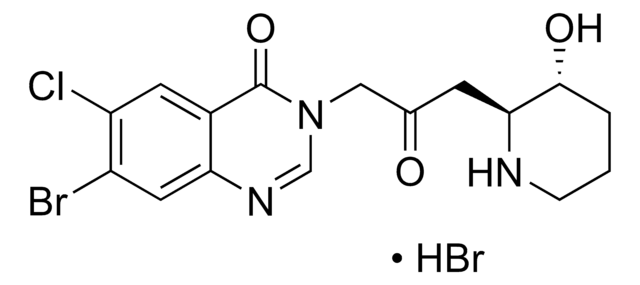SML4058
Florfenicol

≥98% (HPLC)
Synonym(s):
(-)-Florfenicol, 2,2-Dichloro-N-((1R,2S)-3-fluoro-1-hydroxy-1-(4-(methylsulfonyl)phenyl)propan-2-yl)acetamide, 2,2-Dichloro-N-[(1S,2R)-1-(fluoromethyl)-2-hydroxy-2-[4-(methylsulfonyl)phenyl]ethyl]acetamide, SCH 25298
About This Item
Recommended Products
Quality Level
Assay
≥98% (HPLC)
form
powder
color
white to beige
solubility
DMSO: 2 mg/mL, clear
storage temp.
-10 to -25°C
SMILES string
ClC(C(N[C@@H]([C@H](O)C1=CC=C(S(C)(=O)=O)C=C1)CF)=O)Cl
Biochem/physiol Actions
Florfenicol is a broad-spectrum antibiotic that is primarily used in veterinary medicine to treat respiratory infections in cattle and swine, and to prevent Salmonella infection in poultry. It has favorable ADME properties and is a fluorinated analog of chloramphenicol that has good tissue penetration and is resistant to chloramphenicol acetyltransferase inactivation. Florfenicol inhibits ribosomal activity and effectively inhibits bacterial protein synthesis, which makes it effective against various bacteria. However, oral administration of florfenicol may alter animal microbiota.
Signal Word
Danger
Hazard Statements
Precautionary Statements
Hazard Classifications
Aquatic Acute 1 - Aquatic Chronic 1 - Repr. 2 - STOT RE 1
Target Organs
Liver,Brain,Testes,Spinal cord,Blood,gallbladder
Storage Class Code
6.1C - Combustible acute toxic Cat.3 / toxic compounds or compounds which causing chronic effects
WGK
WGK 3
Flash Point(F)
Not applicable
Flash Point(C)
Not applicable
Certificates of Analysis (COA)
Search for Certificates of Analysis (COA) by entering the products Lot/Batch Number. Lot and Batch Numbers can be found on a product’s label following the words ‘Lot’ or ‘Batch’.
Already Own This Product?
Find documentation for the products that you have recently purchased in the Document Library.
Our team of scientists has experience in all areas of research including Life Science, Material Science, Chemical Synthesis, Chromatography, Analytical and many others.
Contact Technical Service








